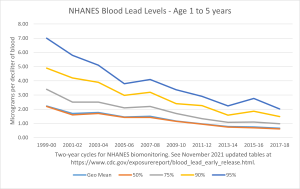
Good news: Blood lead levels in children resume their downward trend
Tom Neltner, Senior Director, Safer Chemicals
It is always worth keeping an eye on the latest U.S. data on blood lead levels in children. While no amount of lead is safe, it is nice to see lower levels reported in findings released by the Centers for Disease Control and Prevention (CDC) late last year.
In case you missed it, blood lead levels decreased among the children most exposed to the heavy metal during the most recent two-year cycle, according to a biomonitoring data report released by CDC.
The 2017-18 data comes from the CDC’s National Health and Nutrition Evaluation System (NHANES), and it is a key measure of overall progress towards reducing children’s exposure to lead from all sources.
In April 2019, we reported disturbing news that after six years of sustained and significant progress, the NHANES 2015-16 cycle showed blood lead levels (BLLs) of the most exposed children 1 to 5 years of age increased compared to the previous two years. We saw a similar trend for children 6 to 11 years of age in the 2015-16 data. At the time, we cautioned that the increase was not statistically significant because of the relatively small sample sizes – between 600 and 800 children in each age range – but was still worth watching.
As the figure above shows, the 20% and greater BLL reductions we saw for the most exposed young children in the two-year cycles from 2007-08 to 2013-14 resumed in 2017-18, the latest two-year period for which there is data. The reductions were 27% for children in the 95th percentile, 20% for the 90th, 11% for the 75th, and 10% for the 50th.
The progress is only statistically significant when looking across many cycles, but any improvement like this is a promising reminder that our collective investments in reducing children’s lead exposure from all sources – whether from paint, pipes, food, soil, or air – make a positive difference. However, as long as lead is in our environment, our water, and our homes, it remains a significant health risk in communities across the country.
It is clear we must strengthen our investments – we recently saw a good step in that direction with the $15 billion for lead pipe replacement in the Biden Administration’s successful infrastructure law. We also must strengthen our standards, including addressing the shortcomings of the Lead and Copper Rule and hazard standards for lead in paint, dust, and soil, and ensure compliance with these requirements as well as the Lead-Based Paint Renovation, Repair, and Painting Rule to avoid backsliding of the kind we saw in the 2015-16 cycle.
Why is the NHANES data important?
NHANES is an ongoing survey assessing the health and nutritional status of a nationally representative sample of about 8,000 children and adults in the United States. The survey includes a biomonitoring study of blood and urine samples to provide national estimates of the population’s exposure to more than 300 chemicals that may result from environmental exposures.
CDC uses the blood lead levels from about 1,000 one-to-five year old children tested every two years to track progress in reducing blood lead levels. The agency’s childhood lead poisoning prevention program (CLPPP) uses the data to adjust federal priorities and identify potential problems. The data also serves as a benchmark that CDC and other federal agencies use to measure progress toward their shared goal of eliminating elevated blood lead levels in children.













